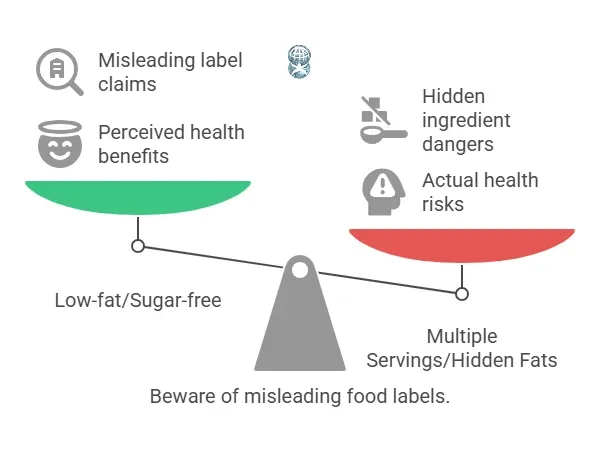Ever felt confused staring at a nutrition label? You're not alone!
Those tiny numbers and big words can seem overwhelming, but learning how to read nutrition labels is one of the smartest things you can do for your health.
Understanding food labels helps you spot hidden sugars, dodge unhealthy fats, and pick foods that truly fuel your body—not just ones that sound healthy.
 |
| How to Read Nutrition Labels for Better Food Choices (Step-by-Step Guide) |
By the end of this guide, you’ll feel confident reading any nutrition label and making choices that match your health goals perfectly. Let's get started!
🔍 Why Nutrition Labels Matter
Nutrition labels are like your personal cheat sheet to making better food choices. They give you the real story—beyond flashy packaging and buzzwords.
✅ Make smarter choices: Know exactly what you're eating.
✅ Compare products easily: Find out which option is genuinely healthier.
✅ Avoid hidden junk: Spot added sugars, sneaky trans fats, and extra calories that could derail your goals.
Once you know how to read them, nutrition labels become your secret weapon for eating healthier every single day.
📋 How to Read a Nutrition Label Step-by-Step
Nutrition labels aren't scary once you know what to look for! Here's a simple, step-by-step way to break it down:
1. Start with Serving Size
First thing’s first—always check the serving size.
A whole bag of chips might look like one snack, but the label might say it’s actually three servings. Sneaky, right?
👉 Tip: If you eat more than the serving size, you have to multiply the calories and nutrients too!
2. Check the Calories
Next up, calories.
Calories are the energy you get from food. Knowing them helps you balance your daily intake so you’re not accidentally overeating—or underfueling!
3. Look at the Macronutrients
Scan for protein, carbs, and fats.
- Want to lose fat? Focus on higher protein, lower added sugar.
- Training hard? Carbs are your fuel.
- Looking for balance? Healthy fats matter too!
4. Watch Out for Added Sugars
Not all sugar is bad—fruit has natural sugar, and that’s okay!
Added sugars, though, sneak into cereals, yogurts, and sauces. Too much can wreck your energy and health goals.
5. Understand the Ingredient List
Ingredients are listed from most to least.
If sugar, corn syrup, or hydrogenated oils show up first, it’s a red flag 🚩.
👉 Tip: The shorter and simpler the ingredient list, the better.
⚠️ Common Nutrition Label Tricks to Watch For
Food companies are clever—and not always in a good way! Here are a few label traps to avoid:
- "Low-fat" or "sugar-free" ≠ healthy: They often pack in more sugar or artificial ingredients to make up for taste.
- Multiple servings per package: A bottle might say 100 calories—but that's for half the bottle!
- Hidden trans fats: Even if it says “0g trans fats,” it can still have up to 0.5g per serving. Always check the ingredient list for “partially hydrogenated oils.”
Stay sharp and don’t let fancy marketing fool you!
 |
| Common Nutrition Label Tricks |
🥗 Healthier Choices: What to Look For on Labels
When you're scanning nutrition labels, here’s the good stuff you want to see:
✅ High fiber: Helps you feel full and supports digestion. Look for at least 3–5g per serving.
✅ Low added sugars: Less than 6g is a solid goal for snacks.
✅ Healthy fats: Think nuts, seeds, olive oil—not mystery oils you can’t pronounce.
✅ Short ingredient lists: If it sounds like a science project, maybe skip it.
👉 Green Flags to Look For:
- "100% whole grain"
- "No added sugars"
- "No artificial colors or preservatives"
Eating better doesn't mean eating perfectly—just getting a little smarter at the grocery store! 🌱
📈 Quick Label Comparison Example
Let’s break it down with a quick real-world example: two granola bars.
| Bar A | Bar B | |
|---|---|---|
| Serving Size | 1 bar (40g) | 1 bar (40g) |
| Calories | 180 | 220 |
| Sugar | 12g (added) | 5g (natural) |
| Fiber | 2g | 5g |
| Protein | 3g | 8g |
| Ingredients | Sugar listed first | Oats, almonds, honey first |
👉 Which one is healthier?
Bar B wins!
- Lower added sugar ✅
- Higher fiber and protein ✅
- Cleaner ingredients ✅
This simple habit—reading and comparing—can seriously level up your food choices without any complicated diet plans. 🙌
❓ FAQs About Nutrition Labels
Are organic foods always healthier?
Not necessarily! "Organic" means how the food was grown—not how nutritious it is. Still gotta read those labels! 🍏What does "daily value %" really mean?
It shows how much a nutrient in one serving contributes to your daily needs. Aim for higher %s on fiber, vitamins, and minerals—and lower on sodium and added sugars.How much sugar per day is okay?
Experts suggest no more than 25g for women and 36g for men. (That’s about 6–9 teaspoons!) 🍯
Should I always choose low-fat options?
Not always! Some low-fat foods sneak in extra sugar or weird additives to make up for the taste. Always check the full label, not just the front!📢 Conclusion
Understanding nutrition labels doesn’t have to feel like decoding a secret language. 📜
Now you know how to spot the sneaky tricks, focus on the important numbers, and make smarter choices for your health.
👉 Next time you shop, flip that package over—you’ve got the knowledge now!
💬 "What’s one food item you’re excited to check the label on? Tell us in the comments!"

